The first peer-reviewed materials database to support medical device design has reached a significant milestone, now providing a total of 22,000 datasheets and literature references for 10,661 cardiovascular and orthopedic devices, 380 materials and 945 specific material grades.

The Materials for Medical Devices Database helps speed the device innovation process “by providing immediate access to key materials knowledge,” said Pam Brown, Product Development Manager for ASM International’s Materials and Processes for Medical Devices (MPMD) initiative.
In a major new extension to the Cardiovascular Module, information has been added for all FDA classifications of catheters and other related interventional devices. Records for these devices have been organized into the following database folders and identified by their U.S. FDA Regulation Number:
Diagnostic Devices: Catheter Cannula (870.1300), Continuous Flush Catheter (870.1210), Electrode Recording (870.1220), Guide Wires (870.1330), and Percutaneous Catheter (870.1250). Surgical Devices: Vascular Clamps (870.4450). Therapeutic Devices: Embolectomy (870.5150) and Septostomy (870.5175).
Characterization, numerical information and links to specific devices have now been completed for 16 materials in the Orthopaedic Module, with bioresponse information added for Poly(lactic Acid)/Hydroxyapatite (HAPLA). In addition, 80 new producers have been added with links to specific devices.
Fully relational and modular, the Materials for Medical Devices Database provides a comprehensive set of mechanical, physical, biological response and drug compatibility properties for the materials and coatings used in medical devices. The database also draws references from 3,700 sources including journal articles, conference proceedings, manufacturer data, USFDA CDRH 510K submissions, PMAs and FDA standards and guidance documents.
Comprehensive reviews of the literature concerning biocompatibility of candidate materials and coatings are peer-reviewed by 75 industry experts. The database continues to expand into materials for neurological and dental applications, as well as additional content for cardiovascular and orthopaedic applications.